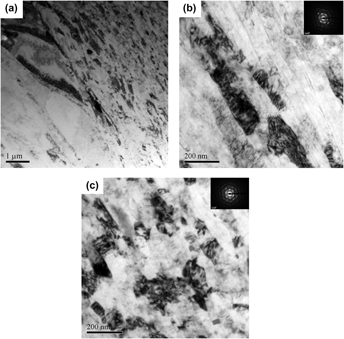Crossref Citations
This article has been cited by the following publications. This list is generated based on data provided by
Crossref.
Yang, Yang
Wang, Zhen
and
Jiang, Lihong
2017.
Evolution of precipitates in ZK60 magnesium alloy during high strain rate deformation.
Journal of Alloys and Compounds,
Vol. 705,
Issue. ,
p.
566.
Edwards, Nathan J.
Song, Wei
Cimpoeru, Stephen J.
Ruan, Dong
Lu, Guoxing
and
Herzig, Norman
2018.
Mechanical and microstructural properties of 2024-T351 aluminium using a hat-shaped specimen at high strain rates.
Materials Science and Engineering: A,
Vol. 720,
Issue. ,
p.
203.
Jenix Rino, J.
Jayaram Krishnan, I.
Balasivanandha Prabu, S.
and
Padmanabhan, K.A.
2018.
Influence of velocity of pressing in RCS processed AA8090 Al-Li alloy.
Materials Characterization,
Vol. 140,
Issue. ,
p.
55.
Asala, G.
Andersson, J.
and
Ojo, O.A.
2018.
Improved dynamic impact behaviour of wire-arc additive manufactured ATI 718Plus®.
Materials Science and Engineering: A,
Vol. 738,
Issue. ,
p.
111.
Jiang, Lihong
Yang, Yang
Wang, Zhen
and
Hu, Haibo
2018.
Microstructure evolution within adiabatic shear band in peak aged ZK60 magnesium alloy.
Materials Science and Engineering: A,
Vol. 711,
Issue. ,
p.
317.
Keshavarz, M.K.
Sikan, F.
Boutet, C.E.
Milligan, J.
Bois-Brochu, A.
and
Brochu, M.
2019.
Impact properties of half stress-relieved and hot isostatic pressed Ti–6Al–4V components fabricated by laser powder bed fusion.
Materials Science and Engineering: A,
Vol. 760,
Issue. ,
p.
481.
Edwards, Nathan J.
Kariem, Muhammad A.
Rashid, R.A. Rahman
Cimpoeru, Stephen J.
Lu, Guoxing
and
Ruan, Dong
2019.
Dynamic shear testing of 2024 T351 aluminium at elevated temperature.
Materials Science and Engineering: A,
Vol. 754,
Issue. ,
p.
99.
Yang, Yang
Yang, Shuangjun
and
Jiang, Lihong
2019.
Study on the microstructural characteristics of adiabatic shear band in solid-solution treated ZK60 magnesium alloy.
Materials Characterization,
Vol. 156,
Issue. ,
p.
109840.
Ye, Tuo
Wu, Yuanzhi
Liu, Anmin
Xu, Congchang
and
Li, Luoxing
2019.
Mechanical property and microstructure evolution of aged 6063 aluminum alloy under high strain rate deformation.
Vacuum,
Vol. 159,
Issue. ,
p.
37.
Yang, Shuangjun
and
Yang, Yang
2020.
Thermodynamics-kinetics of twinning/martensitic transformation in Fe50Mn30Co10Cr10 high-entropy alloy during adiabatic shearing.
Scripta Materialia,
Vol. 181,
Issue. ,
p.
115.
Colliander, Magnus Hörnqvist
Sundell, Gustav
and
Thuvander, Mattias
2020.
Complete precipitate dissolution during adiabatic shear localisation in a Ni-based superalloy.
Philosophical Magazine Letters,
Vol. 100,
Issue. 12,
p.
561.
Alaghmandfard, Reza
Chalasani, Dharmendra
Hadadzadeh, Amir
Amirkhiz, Babak Shalchi
Odeshi, Akindele
and
Mohammadi, Mohsen
2020.
Dynamic compressive response of electron beam melted Ti–6Al–4V under elevated strain rates: Microstructure and constitutive models.
Additive Manufacturing,
Vol. 35,
Issue. ,
p.
101347.
Yang, Yang
Yang, Shuangjun
and
Wang, Zhen
2021.
Microstructure Evolution of Peak-Aged ZK60 Magnesium Alloy under High Strain Rate Deformation.
Journal of Testing and Evaluation,
Vol. 49,
Issue. 6,
p.
4671.
2021.
Li, Z.
Beslin, E.
den Bakker, A.J.
Scamans, G.
Danaie, M.
Williams, C.A.
and
Assadi, H.
2021.
Bonding and microstructure evolution in electromagnetic pulse welding of hardenable Al alloys.
Journal of Materials Processing Technology,
Vol. 290,
Issue. ,
p.
116965.
Yan, Na
Li, Zezhou
Xu, Yongbo
and
Meyers, Marc A.
2021.
Shear localization in metallic materials at high strain rates.
Progress in Materials Science,
Vol. 119,
Issue. ,
p.
100755.
Gwalani, Bharat
Dasari, Sriswaroop
Sharma, Abhishek
Soni, Vishal
Shukla, Shivakant
Jagetia, Abhinav
Agrawal, Priyanshi
Mishra, Rajiv S.
and
Banerjee, Rajarshi
2021.
High density of strong yet deformable intermetallic nanorods leads to an excellent room temperature strength-ductility combination in a high entropy alloy.
Acta Materialia,
Vol. 219,
Issue. ,
p.
117234.
Shin, Ji Ho
Kong, Byeong Seo
Eom, Hyun Joon
Jang, Changheui
Do, Hyeonsu
and
Jang, Dongchan
2021.
Dynamic evolution of nanosized NbC precipitates in austenite matrix during deformation and its contribution to strengthening.
Materials Science and Engineering: A,
Vol. 806,
Issue. ,
p.
140816.
Mills, Sean H.
Dellacorte, Christopher
Noebe, Ronald D.
Amin-Ahmadi, Behnam
and
Stebner, Aaron P.
2021.
Rolling contact fatigue deformation mechanisms of nickel-rich nickel-titanium-hafnium alloys.
Acta Materialia,
Vol. 209,
Issue. ,
p.
116784.
Ma, Huijuan
Mao, Wenjie
Zhao, Ning
Zhu, Hui
Wang, Peiliao
Sun, Qian
Hu, Zhili
Huang, Liang
and
Li, Jianjun
2023.
Mechanical properties and microstructure evolution of 2219 aluminum alloy via electromagnetic ring expansion & electromagnetic treatment.
Journal of Alloys and Compounds,
Vol. 947,
Issue. ,
p.
169615.



